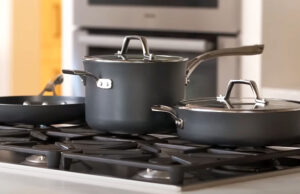As an Amazon Associate, I earn from qualifying purchases at no extra cost to you.
How to Start Your LG Dishwasher (Expert Guide Made Easy)
Last night, I watched a friend stare at her shiny LG dishwasher like it was a puzzle box. She whispered, “Why won’t it start?” and honestly, I remembered my first time too. Buttons blink, options flash, and you wonder if you missed something tiny. So today, let’s walk through it together in the easiest way possible, step by step, without feeling lost or rushed.
To begin, make sure the dishwasher has power, load dishes correctly, add detergent, pick a wash cycle, choose options like sanitize if needed, and press start while closing the door firmly. Check that water is connected, avoid blocking spray arms with large dishes, clean filters regularly, and always listen for the initial water fill sound to confirm operation. Stay near for a moment in case alerts appear.
Check Power and Water Connection
Before anything else, you want to make sure your LG dishwasher actually has power and water. It may sound obvious, yet so many times the simplest thing causes the delay. Imagine being all set to clean after dinner, only to learn the plug got loose when someone mopped the floor. So, always glance behind and ensure the plug is snug and outlet working.
Next, confirm your water supply valve is turned on. People often forget they turned it off during plumbing maintenance, and then nothing happens when they hit start. I once spent ten minutes pressing buttons, thinking the machine froze, but really I had shut off the water earlier. Just twist the valve open fully and you’re good. It saves stress.
Also check that the dishwasher door closes smoothly without resistance. If crumbs or utensils block the door seal, the machine won’t start. I had a spoon once stuck by the hinge, and it took a bit to notice. Gently wipe the door area, remove anything in the way, and listen for the latch click. That sound gives peace of mind.
If you use a power strip, try plugging directly into the wall instead. Dishwashers can draw steady current, and a faulty strip can interrupt that. When you press start, notice if lights flicker or panel dims. Any unusual flicker hints at power issues. Better to fix those early than wonder mid-cycle why the unit paused.
• Confirm plug is secure
• Open water valve fully
• Make sure door latches cleanly
• Avoid unreliable power strips
Load the Dishes Properly for Best Cleaning
Loading dishes right matters more than people expect. When plates stack too close, water jets don’t reach everything, and you end up rewashing sticky forks. That’s no one’s favorite chore. So begin by placing plates facing toward the spray center, spaced slightly apart. Think of giving each dish its personal bubble. It really changes cleaning results.
Bowls and cups go on the top rack, angled slightly so water rinses off instead of pooling. I once loaded bowls flat, thinking it didn’t matter. Later, I found little puddles inside. Now I angle them, and drying improves so much. If you have tall bottles, use the adjustable tines; LG racks often adjust easily with one hand. It feels neat when you snap shelves into place.
Silverware deserves attention too. Mix different utensils so they don’t spoon each other and create stuck food zones. Place some handles up, some down, but keep sharp knives handle-up for safety. I used to pile everything in one corner when rushing, and it always caused cloudy spots. Balance is key; it takes seconds but saves time later.
Avoid blocking the spray arms. Spin them gently before starting to see if anything hits, like a big pan handle. If arms can’t move freely, water won’t reach all corners. I once loaded a large baking tray upright on the side, thinking it was clever, but it stopped the arm completely. Now I place large pans along the bottom edges instead.
• Face plates inward
• Angle cups and bowls
• Mix silverware spacing
• Ensure spray arms spin freely
Add the Right Detergent and Rinse Aid
Choosing the right detergent makes a big difference. Use dishwasher-specific detergent tablets or powder, never regular dish soap. Otherwise, you might see bubbles fill your kitchen floor, and that moment is both funny and stressful. Tablets work well for busy nights since you just drop them in. Powder gives control if water hardness varies in your home.
Open the detergent dispenser gently and place the detergent in the marked compartment. Avoid overfilling, because extra detergent doesn’t mean extra clean; it can leave chalky residue. I once filled past the line thinking it’d help with greasy pans, but it only caused streaks. Following the fill line became my go-to trick to avoid cleanup later.
Rinse aid helps water glide off dishes, reducing spots. Some people skip it, but glassware really shines with it added. Fill the rinse aid compartment until you see it almost reach the top, then close firmly. When the “rinse aid” light appears on your LG dishwasher, that means it needs a refill. I like refilling as soon as I notice, so I don’t forget midweek.
Be sure to wipe any spilled detergent around the dispenser, since clumps can harden like glue. If the dispenser door doesn’t close, check for stray granules. I’ve tapped it shut before without thinking, and then it popped open during cycle. Cleaning the edges with a tiny brush works wonders, and keeps things smooth for future washes.
• Use dishwasher-safe detergent
• Follow fill line exactly
• Add rinse aid for shiny glass
• Clean dispenser edges
Select a Wash Cycle That Fits Your Load
Choosing cycles can feel confusing the first time. Yet once you know what each button does, it becomes second nature. Normal cycles work for everyday plates and bowls with light or moderate food. When I cook pasta and vegetables, that’s my go-to. It balances cleaning power and time, which fits most kitchens on busy weeknights.
For pots, casseroles, or dried food bits, the Heavy cycle works wonders. I love using it after big family dinners when bakeware looks hopeless. It runs longer, uses more heat, and handles stubborn stains. Sometimes I laugh thinking back to when I scrubbed by hand unnecessarily. Now I just load and press heavy. Life feels smoother with that option.
Quick wash cycles are handy for lightly soiled dishes or fast turnarounds, like when guests leave suddenly and you want clean coffee mugs again. It won’t handle dried-on cheese, but it’s perfect for fresh cups and plates. If unsure, ask yourself how dirty things look. Choosing wisely saves energy and water, and still gives sparkling results.
Some LG dishwashers offer steam or sanitize modes. Steam loosens hardened food, and sanitize boosts heat to kill germs. When someone in my home had a cold, I used sanitize on utensils for peace of mind. Just remember these modes may extend time. Listening to the machine hum longer isn’t a problem if you want deeper cleaning.
• Normal for daily loads
• Heavy for tough messes
• Quick for light soil
• Steam or sanitize when needed
Start the Cycle and Close the Door Securely
After selecting cycle and options, press the Start button. Then, close the door firmly until you hear the latch click. LG models usually need the door shut within a few seconds after pressing start, so don’t wander off before closing. I’ve walked away to grab water, returned, and wondered why nothing ran. Timing matters just a little here.
Watch for lights or short beeps after pressing start. They confirm the machine registered your choice. If you don’t see anything change, re-press the button with a steady touch. Sometimes a light tap doesn’t register. When the door closes, you may hear a brief pause and then water filling. That soft swoosh sound is a good sign everything’s working correctly.
Avoid opening the door right after starting, unless necessary. Opening breaks the latch trigger and pauses the cycle. If you realize you forgot a fork, just open carefully, add it, and close again. In my kitchen, I try to double-check before hitting start, because forgetting that one tiny spoon always feels comical. But it happens, and LG dishwashers handle pauses well.
If you see blinking lights or the unit beeps instead of starting, check alerts on the display. Sometimes it signals something simple like not enough water pressure or door not sealed. Taking a moment to read the symbol saves frustration. Once all looks right, press start again with confidence and let the machine do its quiet magic.
• Press start before closing
• Listen for latch click
• Look for fill sound
• Pause only if needed
Monitor the Start and Troubleshoot Early
Even after everything begins, take a minute to ensure smooth operation. Listen for unusual sounds like repetitive clicks or no water flowing at all. I like standing nearby for the first minute, kind of like watching bread rise even though nothing dramatic happens. Catching issues early saves time, especially when schedules are tight.
If the panel flashes error codes, most LG models show clear icons. For instance, a little faucet symbol can mean water supply issue. When I once saw that, I gently opened and re-closed the water valve, then restarted. It worked instantly. Instead of panicking, think of the dishwasher as giving friendly hints. A quick steady breath helps too.
Feel around the door seal for warmth after a few minutes. A slight warmth means the heating process has begun, which is normal. But if you feel no warmth and hear no water, revisit cycle selection and power. Avoid pulling the appliance or tapping panels aggressively. Most problems come from small settings, not big failures.
Finally, check for leaks or drips near the base. Even a tiny puddle means something might be blocking the door seal or hose connection. I once found a fork stuck near the bottom edge causing a poor seal. Removed it, wiped the edge, and restarted. These little checks keep your dishwasher running quietly for years.
• Listen for odd sounds
• Watch error symbols
• Feel gentle warmth
• Check for tiny leaks
Final Thoughts
Starting an LG dishwasher becomes second nature once you learn the flow. A few mindful habits, like proper loading and checking the latch, keep everything running smooth. With each cycle, you’ll feel more confident pressing buttons, choosing modes, and listening for that first water rush. Soon you’ll hit start and walk away smiling, knowing dinner cleanup is handled.
| Task | What to Do | Quick Tip |
|---|---|---|
| Power check | Ensure plug and breaker are on | Avoid power strips |
| Water supply | Open water valve fully | Check hose kinks |
| Load dishes | Space items and avoid blocking arms | Mix utensils |
| Add detergent | Fill dispenser to line | Use rinse aid |
| Choose cycle | Match soil level to mode | Use heavy for pots |
| Start machine | Press start then close firmly | Listen for fill sound |
| Monitor | Look for beeps or leaks | Stand nearby briefly |
| Pause/Restart | Open carefully if needed | Re-latch securely |
Frequently Asked Questions (FAQs)
Is it difficult to learn how to start a LG dishwasher?
Learning how to start a LG dishwasher feels easy once you follow a routine. At first, all the buttons and lights might look like a control panel from a spaceship. But after one or two runs, the steps start clicking in your mind. Plug in, load, add detergent, pick a cycle, press start, close the door—done. When I showed my cousin, she was nervous about pressing the wrong option, but soon she was explaining it back confidently. Take a moment to read the symbols, double-check placement of dishes, and listen for running water. Before long, you’ll feel totally comfortable.
Can I open the dishwasher right after pressing start?
You can open the dishwasher after pressing start, but it pauses the cycle automatically. Think of it like pausing a movie; the machine waits patiently until you return. Sometimes you suddenly remember a mug hiding on the counter, and that happens to everyone. When you open the door, steam won’t appear immediately in the beginning phase, so don’t panic if it seems quiet. Just add the dish, shut the door firmly, and the machine picks up again. Try not to open frequently though, because each interruption slightly affects rhythm and water temperature. One quick opening is perfectly fine for most loads.
Do I need to pre-rinse dishes before starting?
You don’t strictly need to pre-rinse, and many LG dishwashers handle food residue well. However, scraping large pieces is helpful. I once left big chunks of rice, and while the dishwasher cleaned, the filter needed more effort afterward. Instead, I now give plates a light scrape into the trash. Sauces and small crumbs are okay; that’s what cycles handle. Pre-rinsing heavily can even reduce cleaning power because detergent works best with a little soil present. So aim for balance—remove heavy debris, but don’t scrub spotless before loading. This saves time and water, while keeping filters cleaner longer.
Is it okay to leave dishes inside after the cycle ends?
Yes, you can leave dishes inside after the cycle ends, but not too long if you want fresh-smelling results. Warm, closed space with moisture sometimes encourages odors if dishes sit for days. I often crack the door slightly right after the beep to release steam. It helps everything dry even better. If you run loads at night, unloading in the morning works great. Just avoid stuffing dishes back-to-back without air. Occasionally wiping the door gasket keeps smells away too. Overall, leaving them overnight is perfectly fine, just don’t forget them for extended periods. A quick check keeps things pleasant.
Can I add extra detergent for very dirty dishes?
It’s tempting to add extra detergent for dirty dishes, but it usually backfires. More soap doesn’t equal cleaner plates; instead it can leave chalky residue on glass and create cloudy film. I made that mistake once when washing greasy barbecue plates. The result was a film that felt sticky, not clean. Instead, use the Heavy or Steam mode for tough messes. Add rinse aid and consider a soaking cycle if your model has one. Keeping detergent at recommended level protects your dishwasher too, because undissolved excess can clog parts. Quality cycles, not extra detergent, deliver the deep clean you want.
Do I need rinse aid if I use detergent pods?
Detergent pods often contain some rinse aid, but many kitchens still benefit from extra. If you notice water spots, streaks, or less shine on glass, adding dedicated rinse aid helps a lot. I live in an area with hard water, and once I started filling the rinse aid reservoir regularly, glasses looked sparkling again. Pods do great for cleaning, and rinse aid handles smooth drying. Think of them as teammates. If unsure, try running a load without rinse aid and observe. If the dishes don’t dry as nicely or you see faint marks, add rinse aid next cycle and compare.
Is it normal for the dishwasher to pause during a cycle?
Yes, it’s completely normal for an LG dishwasher to pause briefly. The machine pauses when changing spray direction, adjusting water temperature, or letting detergent dissolve. The first time I heard silence mid-cycle, I thought it stopped working. A few seconds later, the soft hum returned. If the pause lasts unusually long, check the display for symbols. But most pauses are part of its efficiency pattern. As long as you don’t hear constant error beeps or see leaks, small gaps in sound are expected. It helps the dishwasher deliver targeted cleaning and smart water use.
Can I run a half-full load?
You can run a half-full load, but it’s more efficient to fill racks properly. Modern LG dishwashers use less water, but every cycle still uses energy. Sometimes life doesn’t follow schedules, and you need clean dishes sooner. In those moments, feel free to run it. Just try to spread items for best spray coverage. I sometimes do half loads after busy baking days when I need bowls quickly. If your model has a Half Load option, use it for improved efficiency. Keeping a steady habit of fuller loads saves water and time long-term while still giving flexibility when needed.




